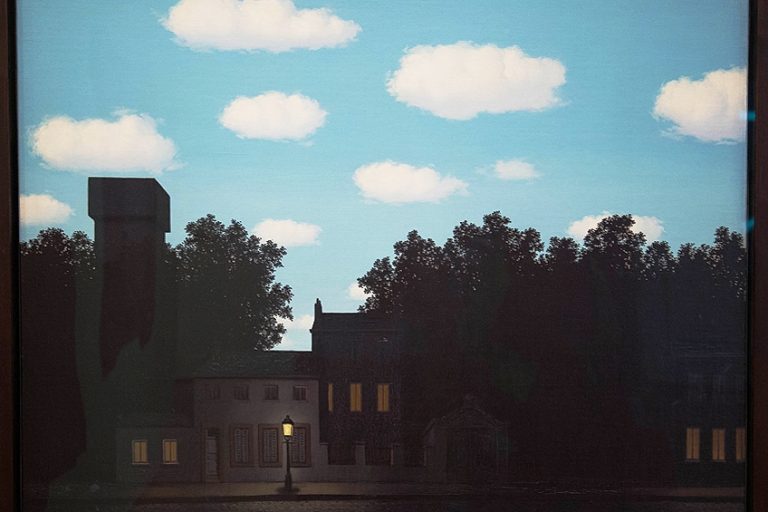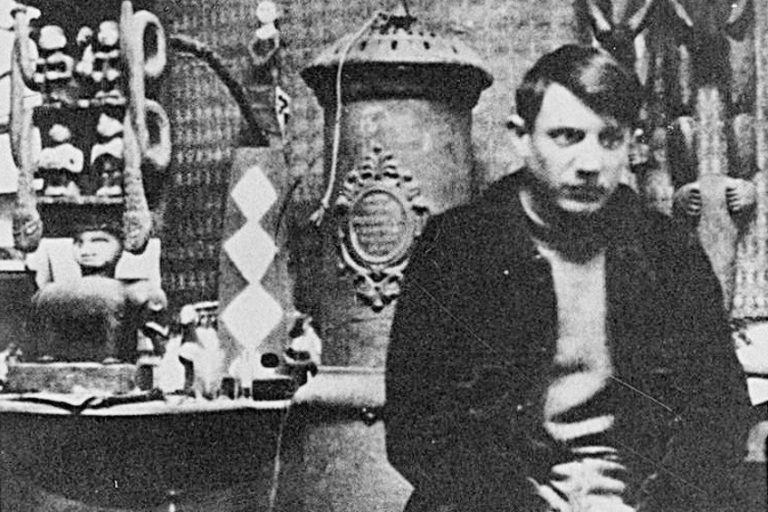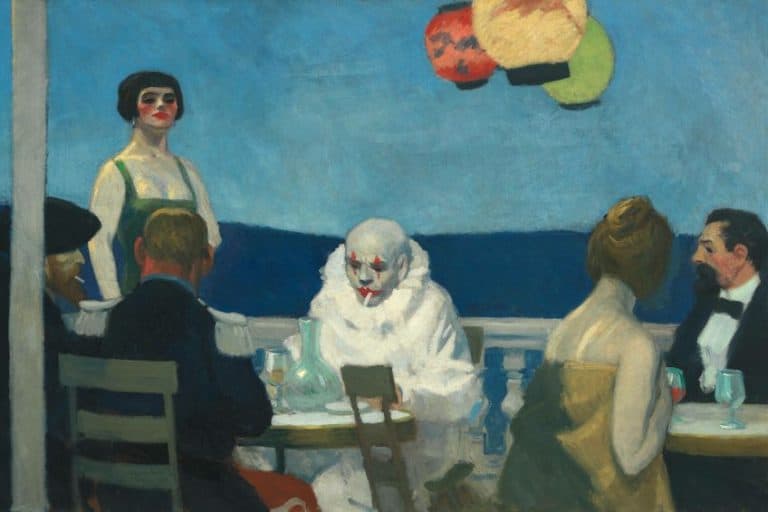“Office at Night” by Edward Hopper – A Study in Tension
Edward Hopper’s Office at Night, painted in 1940, is a quintessential example of the artist’s mastery in capturing the nuances of urban life and the isolation within it. Painted during the height of his career, this work depicts a sparsely furnished office, where a man at his desk and a woman standing nearby are enveloped in an atmosphere thick with unspoken tension. Hopper’s use of light and shadow, combined with his precise architectural lines, accentuates the emotional distance between the figures while hinting at a narrative left to the viewer’s imagination. Office at Night is a compelling study of the intersection between personal and professional spaces, revealing the complexities of human relationships within the modern American cityscape.
Key Takeaways
- Office at Night by Edward Hopper captures a moment of stillness and tension.
- The painting features a young woman and an older man in an office illuminated by artificial lights.
- Hopper’s detailed composition invites viewers to interpret the underlying narrative and emotions.
Historical Context and Significance
| Artist | Edward Hopper (1882 – 1967) |
|---|---|
| Date Created | 1940 |
| Medium | Oil on canvas |
| Genre | Realism |
| Period/Movement | American Realism |
| Dimensions (cm) | 56.4 × 63.8 |
| Series/Versions | Single version |
| Where Is It Housed? | Walker Art Center, Minneapolis, Minnesota, United States |
| What It Is Worth | Not publicly auctioned; significant cultural and historical value |
Edward Hopper’s Office at Night paints a vivid scene capturing a moment of stillness and tension. The 1940 oil-on-canvas artwork by the American realist artist depicts an office with a young woman in a blue dress and an older man, sparking curiosity about their relationship and the narrative behind their interaction. The painting’s setting, an office illuminated by artificial lights, enhances the mysterious and suspenseful atmosphere. The Walker Art Center in Minneapolis has owned Office at Night since 1948, after acquiring it from Hopper.

The scene encapsulates Hopper’s signature style, blending realism with a sense of quiet drama. The lighting plays a crucial role, with sources including overhead lights and a desk lamp, creating contrasting shadows and highlights that draw the viewer’s eye. Hopper’s meticulous attention to detail and composition invites various interpretations and insights. Is there an underlying tension between the characters? Does the office setting suggest themes of isolation and routine?
These elements make Office at Night a compelling piece, urging viewers to find their own stories within the frame.
Hopper’s Artistic Influence
Edward Hopper’s work, including Office at Night, significantly shaped American realism. His realistic style contrasted with the abstract trends of his time. Hopper used New York City as a backdrop, focusing on isolated moments in urban settings. This painting is no exception, showing a quiet office scene.

The Walker Art Center in Minneapolis acquired Office at Night in 1948. It has since been displayed there and previously appeared at the Whitney Museum of American Art. Hopper’s use of light and shadow in this oil-on-canvas painting adds depth, evoking an emotional response from viewers.
His influence continues to be felt in the art world, with Office at Night standing as a testament to his contributions.
Analysis of Artistic Elements
Edward Hopper’s Office at Night is a masterful example of how composition, color, light, and perspective come together to create a rich emotional and visual experience. Each element plays a crucial role in drawing the viewer into the scene and evoking a sense of spatial anxiety and intrigue.
Subject and Themes
The painting depicts a small office space, late at night. A young woman in a short-sleeved blue dress is bending over an open file cabinet, while an older man sits at a desk, seemingly engrossed in paperwork. The scene suggests themes of isolation, tension, and implied intimacy. The contrast between the two figures speaks to a potential narrative of a working relationship with an underlying tension. The viewer’s position outside the scene, looking in, emphasizes a voyeuristic aspect, enhancing the sense of intrusion and spatial anxiety.
Color and Light
The colors in the painting are muted and dominated by blues and grays, which help convey the nighttime setting and a feeling of melancholy. The sharp contrast between light and shadow is prominent, with a single light source illuminating the office. This light casts dramatic shadows, creating a stark division between lit and unlit areas.
The light hitting the young woman’s dress and the desk highlights their importance and draws the viewer’s eye to these focal points.
Composition and Perspective
Hopper’s use of composition and perspective contributes significantly to the painting’s emotional impact. The elevated angle of view places the viewer at a distance, yet directly engaged with the scene. This elevated train-like perspective causes a rational yet irrational space, where everything feels both intimate and detached. The arrangement of figures and objects creates tension, with the vertical blinds on the wall lending a sense of confinement and privacy. The spatial relationship between the man and the woman, the distance yet connection, adds to the sexual interpretation and psychological tension within the confined office space. In conclusion, Office at Night skillfully uses artistic elements to explore complex themes and emotions.

Interpretations and Insights
Office at Night by Edward Hopper is often analyzed for the complex dynamics and emotions it captures. This section explores the relationship between the characters and the psychological subtleties present.
Characters’ Relationship
The scene contains two central figures: a man and a woman. The man, dressed in a three-piece suit, stands at the window, seemingly lost in thought. His position suggests authority, possibly indicating he is a lawyer or executive. In contrast, the woman, likely a secretary, is clad in a blue dress, focusing on an open file cabinet. The contrast in their activities and positions hints at a power dynamic, yet their mutual silence creates a tension. Viewers often perceive a sexual interpretation: the suggestive nature of the scene.
The closed, intimate office space and the late hour may imply an unspoken attraction or unresolved conflict.
Psychological Undercurrents
Hopper’s painting evokes a sense of isolation and anxiety. The man gazing out of the window can be interpreted as feeling trapped or distracted, perhaps by inner conflict. His posture and the distance between the figures emphasize his mental distance from the scene. The woman’s concentrated activity and the neatly arranged office reflect her role’s routine nature, yet her standing position shows potential restlessness. This split between action and stillness creates a blend of tension and monotony. Together, these elements convey a broader psychological undercurrent—the human experience of being physically present yet emotionally distant, further magnified by the empty, quiet office.

Artwork Provenance and Reception
Office at Night by Edward Hopper is a significant work that has garnered attention for its quiet, mysterious atmosphere and has a rich history of exhibition and ownership.
Critical Reception and Exhibition
Edward Hopper’s Office at Night has been praised for its ability to capture the essence of office life during late hours. Critics have admired its use of light and shadow to create a sense of isolation and tension. The painting was first displayed at the Salmagundi Club during its 75th Anniversary Exhibition, where it won a prize of $1,000, highlighting its immediate impact.
Since then, Office at Night has been featured in various prestigious exhibitions.
Its realistic portrayal of office interiors and the nuanced relationship between the figures have been subjects of much discussion. The work exemplifies Hopper’s skill in creating evocative scenes that provoke thought and emotion.
Current Location and Legacy
Office at Night is currently housed at the Walker Art Center in Minneapolis, Minnesota. The museum acquired the painting in 1948, securing its place in a prominent collection. Over the years, it has been displayed at several other institutions, including the Whitney Museum of American Art, further solidifying its status in the art world.

The painting’s legacy continues to influence contemporary discussions about office environments and their emotional impact. Hopper’s portrayal of mundane spaces as sites of significant human experience has left a lasting mark on both art lovers and critics. The work remains a powerful example of American realism and continues to attract attention and admiration.
Office at Night stands as a poignant testament to Edward Hopper’s ability to evoke profound emotional resonance through seemingly mundane scenes. The painting’s meticulous composition, characterized by its interplay of light and shadow, captures the isolation and quiet tension of urban existence. Hopper’s nuanced portrayal of his subjects, set against the backdrop of a 1940s office, invites viewers to contemplate the unseen dynamics and narratives at play. In essence, Office at Night not only reflects the era’s socio-economic realities but also continues to engage contemporary audiences with its timeless exploration of human solitude and connection.
Frequently Asked Questions
What Does Office at Night Signify in Terms of Its Thematic Content?
The painting depicts two individuals, a man and a woman, working late at an office. The scene captures a sense of isolation and unspoken tension between the characters. The distance between them and their detached expressions suggest a lack of connection, a common theme in Hopper’s work.
How Are Light and Shadow Used in the Painting, Office at Night?
Hopper uses light and shadow to create a dramatic and somber atmosphere. The light from a desk lamp sharply outlines the figures, emphasizing their emotional distance. Shadows cast on the walls and floor add depth and a sense of emptiness to the room, enhancing the feeling of loneliness.
What Aspects of American Life in the 1940s Does Office at Night Encapsulate?
The painting reflects the work culture of 1940s America, emphasizing long hours and dedication. The small office with basic furnishings mirrors the modesty of the era. The male and female figures also hint at workplace dynamics and gender roles, as the woman appears to be a secretary or assistant.
Isabella studied at the University of Cape Town in South Africa and graduated with a Bachelor of Arts majoring in English Literature & Language and Psychology. Throughout her undergraduate years, she took Art History as an additional subject and absolutely loved it. Building on from her art history knowledge that began in high school, art has always been a particular area of fascination for her. From learning about artworks previously unknown to her, or sharpening her existing understanding of specific works, the ability to continue learning within this interesting sphere excites her greatly.
Her focal points of interest in art history encompass profiling specific artists and art movements, as it is these areas where she is able to really dig deep into the rich narrative of the art world. Additionally, she particularly enjoys exploring the different artistic styles of the 20th century, as well as the important impact that female artists have had on the development of art history.
Learn more about Isabella Meyer and the Art in Context Team.
Cite this Article
Isabella, Meyer, ““Office at Night” by Edward Hopper – A Study in Tension.” Art in Context. June 12, 2024. URL: https://artincontext.org/office-at-night-by-edward-hopper/
Meyer, I. (2024, 12 June). “Office at Night” by Edward Hopper – A Study in Tension. Art in Context. https://artincontext.org/office-at-night-by-edward-hopper/
Meyer, Isabella. ““Office at Night” by Edward Hopper – A Study in Tension.” Art in Context, June 12, 2024. https://artincontext.org/office-at-night-by-edward-hopper/.











